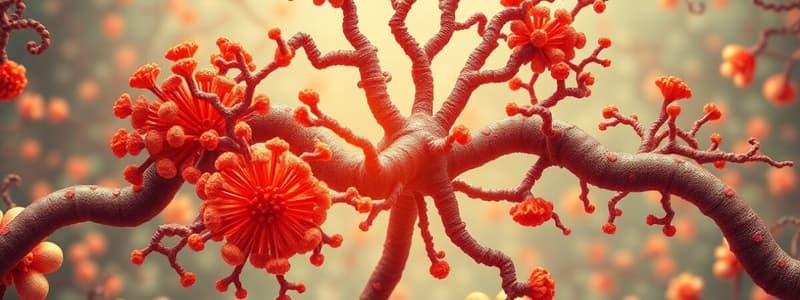Podcast
Questions and Answers
What is the first step in the scientific method?
What is the first step in the scientific method?
- Communicate methods, results, and conclusions
- Design experiments to test the hypothesis
- Draw a conclusion
- Make an observation and ask a question (correct)
What is a hypothesis?
What is a hypothesis?
- A testable explanation for a phenomenon (correct)
- The final conclusion drawn from an experiment
- A specific type of experiment
- A statement of fact observed in nature
Why is a control included in experiments?
Why is a control included in experiments?
- To ensure that all variables are accounted for
- To rule out alternative explanations (correct)
- To provide a visual representation of the data
- To make the experiment more complex
What does the scientific method emphasize after analyzing data?
What does the scientific method emphasize after analyzing data?
What characterizes a scientific theory?
What characterizes a scientific theory?
Which part of the scientific method can be refined based on experimental results?
Which part of the scientific method can be refined based on experimental results?
What is the importance of communicating methods and results in science?
What is the importance of communicating methods and results in science?
What does the phrase 'every rule has exceptions' imply about scientific rules?
What does the phrase 'every rule has exceptions' imply about scientific rules?
What term describes spherical bacteria that may be slightly oval or flattened on one end?
What term describes spherical bacteria that may be slightly oval or flattened on one end?
Which of the following terms refers to a long, spiral-shaped cell with a flexible cell wall?
Which of the following terms refers to a long, spiral-shaped cell with a flexible cell wall?
What term is used for cocci that remain in pairs after division?
What term is used for cocci that remain in pairs after division?
Which bacterial arrangement describes long chains formed by division in one plane?
Which bacterial arrangement describes long chains formed by division in one plane?
What characteristic defines bacteria that can appear in varying shapes?
What characteristic defines bacteria that can appear in varying shapes?
What is the primary difference between Archaea and Bacteria?
What is the primary difference between Archaea and Bacteria?
Which genus of bacteria is known for forming cubical packets after division in perpendicular planes?
Which genus of bacteria is known for forming cubical packets after division in perpendicular planes?
Which type of bacteria often thrive in extreme environments, such as high salt and temperature?
Which type of bacteria often thrive in extreme environments, such as high salt and temperature?
What is the correct order of information flow in cellular processes?
What is the correct order of information flow in cellular processes?
What significant event occurred around 2.5 billion years ago in Earth's history?
What significant event occurred around 2.5 billion years ago in Earth's history?
What do the lengths of the lines in the Universal Tree of Cellular Life represent?
What do the lengths of the lines in the Universal Tree of Cellular Life represent?
Which of the following is NOT one of the four RNA bases?
Which of the following is NOT one of the four RNA bases?
How old is the Earth estimated to be?
How old is the Earth estimated to be?
The simplest assembly of life's origins suggests that all cellular life evolved from what?
The simplest assembly of life's origins suggests that all cellular life evolved from what?
Which of the following statements best describes the process of evolution mentioned?
Which of the following statements best describes the process of evolution mentioned?
What is a common misconception about mutations in DNA?
What is a common misconception about mutations in DNA?
What was the impact of the influenza pandemic of 1918 to 1919 compared to world wars?
What was the impact of the influenza pandemic of 1918 to 1919 compared to world wars?
What factor contributed to the great famine in Ireland during the 1800s?
What factor contributed to the great famine in Ireland during the 1800s?
What consequences did the disease affecting olive trees have?
What consequences did the disease affecting olive trees have?
What was the historical perception of diseases before the discovery of microorganisms?
What was the historical perception of diseases before the discovery of microorganisms?
Which disease devastated wheat crops and spread to various countries?
Which disease devastated wheat crops and spread to various countries?
Which of the following methods was used in ancient times for food preservation?
Which of the following methods was used in ancient times for food preservation?
What was the purpose of the sanitation instructions found in Deuteronomy 23:12-14?
What was the purpose of the sanitation instructions found in Deuteronomy 23:12-14?
Which of the following statements is true about smallpox?
Which of the following statements is true about smallpox?
How is the current situation with the plague characterized?
How is the current situation with the plague characterized?
What evolution-focused behavior do microorganisms display according to the content?
What evolution-focused behavior do microorganisms display according to the content?
What misconception did ancient civilizations have about sanitation practices?
What misconception did ancient civilizations have about sanitation practices?
What remains a challenge in the vaccination efforts for polio?
What remains a challenge in the vaccination efforts for polio?
What recent emerging disease is mentioned alongside smallpox eradication?
What recent emerging disease is mentioned alongside smallpox eradication?
Which of the following is NOT mentioned as an impact of microorganisms on humans today?
Which of the following is NOT mentioned as an impact of microorganisms on humans today?
In ancient medicine, what was the main approach to understanding diseases?
In ancient medicine, what was the main approach to understanding diseases?
Which of the following correctly describes the relationship between microorganisms and human diseases?
Which of the following correctly describes the relationship between microorganisms and human diseases?
What structure do molds form that is visible to the naked eye?
What structure do molds form that is visible to the naked eye?
Which of the following is characteristic of fungi?
Which of the following is characteristic of fungi?
In which part of algae does photosynthesis take place?
In which part of algae does photosynthesis take place?
What is the role of enzymes secreted by fungi?
What is the role of enzymes secreted by fungi?
Which of the following is NOT true about algae?
Which of the following is NOT true about algae?
What type of infections can fungi cause?
What type of infections can fungi cause?
What distinguishes the cell walls of algae from those of prokaryotes?
What distinguishes the cell walls of algae from those of prokaryotes?
Which statement about fungi is correct?
Which statement about fungi is correct?
Flashcards
Central Dogma
Central Dogma
The flow of genetic information from DNA to RNA to protein. This is the central dogma of molecular biology.
RNA Bases
RNA Bases
The four building blocks of RNA: adenine (A), guanine (G), cytosine (C), and uracil (U).
Evolution by Inheritance
Evolution by Inheritance
A process of evolution where successful traits are passed down to offspring. This is the basis of natural selection.
Terraforming
Terraforming
Signup and view all the flashcards
Universal Tree of Life
Universal Tree of Life
Signup and view all the flashcards
Evolutionary Time
Evolutionary Time
Signup and view all the flashcards
Single-celled Ancestor
Single-celled Ancestor
Signup and view all the flashcards
Geological Timeline
Geological Timeline
Signup and view all the flashcards
Diseases
Diseases
Signup and view all the flashcards
Etiology
Etiology
Signup and view all the flashcards
Etiology
Etiology
Signup and view all the flashcards
Sanitation
Sanitation
Signup and view all the flashcards
Malaria from 'bad air'
Malaria from 'bad air'
Signup and view all the flashcards
Fermentation for Preservation
Fermentation for Preservation
Signup and view all the flashcards
Microorganisms and Disease
Microorganisms and Disease
Signup and view all the flashcards
Microorganism Intent
Microorganism Intent
Signup and view all the flashcards
Algae
Algae
Signup and view all the flashcards
Fungi
Fungi
Signup and view all the flashcards
Hyphae
Hyphae
Signup and view all the flashcards
Mycelium
Mycelium
Signup and view all the flashcards
Spores (Conidia)
Spores (Conidia)
Signup and view all the flashcards
Mushroom
Mushroom
Signup and view all the flashcards
Opportunistic Fungal Infections
Opportunistic Fungal Infections
Signup and view all the flashcards
Systemic Fungal Infections
Systemic Fungal Infections
Signup and view all the flashcards
Microorganisms > Humans
Microorganisms > Humans
Signup and view all the flashcards
Influenza Pandemic v Wars
Influenza Pandemic v Wars
Signup and view all the flashcards
Coccus
Coccus
Signup and view all the flashcards
Indirect Microbial Impact
Indirect Microbial Impact
Signup and view all the flashcards
Potato Famine & Microbes
Potato Famine & Microbes
Signup and view all the flashcards
Bacillus
Bacillus
Signup and view all the flashcards
Olive Tree Disease
Olive Tree Disease
Signup and view all the flashcards
Vibrio
Vibrio
Signup and view all the flashcards
Wheat Blast
Wheat Blast
Signup and view all the flashcards
Spirillum
Spirillum
Signup and view all the flashcards
Spirochete
Spirochete
Signup and view all the flashcards
Chytridiomycosis
Chytridiomycosis
Signup and view all the flashcards
Smallpox Eradication
Smallpox Eradication
Signup and view all the flashcards
Pleomorphic
Pleomorphic
Signup and view all the flashcards
Diplococci
Diplococci
Signup and view all the flashcards
Streptococci
Streptococci
Signup and view all the flashcards
What is a hypothesis?
What is a hypothesis?
Signup and view all the flashcards
What is a control in an experiment?
What is a control in an experiment?
Signup and view all the flashcards
What is a scientific theory?
What is a scientific theory?
Signup and view all the flashcards
How does the scientific method work?
How does the scientific method work?
Signup and view all the flashcards
Scientific Rules: Why are exceptions important?
Scientific Rules: Why are exceptions important?
Signup and view all the flashcards
In this course, how will we use rules?
In this course, how will we use rules?
Signup and view all the flashcards
Is the scientific method linear?
Is the scientific method linear?
Signup and view all the flashcards
Where do observations fit into the scientific method?
Where do observations fit into the scientific method?
Signup and view all the flashcards
Study Notes
The Scientific Method
- Describes the process of science
- Make an observation and ask a question
- Develop a testable explanation (hypothesis)
- Design experiments to test the hypothesis
- Include a control to eliminate alternative explanations
- Conduct the experiment, collect and analyze data
- Draw a conclusion
- Communicate methods, results, and conclusions
- Scientific theory: explanation supported by significant evidence
Scientific Rules
- Rules have exceptions
- Understanding exceptions strengthens rule utility
- Exceptions occur throughout the semester
- Seek clarification of exceptions during office hours
- Examples include the flow of information from DNA to RNA to protein, and the four RNA bases (A, G, C, and U)
Information Stored in Nucleic Acids (DNA or RNA)
- Instruction and grading are challenging
- Situations sometimes require educated guesses
- Correct guesses lead to survival, reproduction, and generational memory
- Process is slow, with many unsuccessful attempts
- Time scale is difficult to grasp
Universal Tree of Cellular Life
- Assesses the accumulation of mutations in DNA
- Length of lines reflects evolutionary time
- All cellular life evolved from a single-celled ancestor
- Earth is approximately 4.6 billion years old
- Life originated 3.5-3.8 billion years ago
- Early life shaped the planet's environment, introducing oxygen.
- Life spread and evolved to thrive in diverse habitats.
Microorganisms Affecting Humans
- Microorganisms (MOs) affect humans in various ways
- Their presence in the human microbiome
- Influence on environmental processes
- Commercial use (food, preservation, biodegradation, compounds)
- Research tools
- Infectious disease overview
Human Diseases and Microorganisms
- Humans have long recognized diseases distinct from physical injury
- Often associated with environmental factors or poisons
- Ancient civilizations understood the significance of sanitation but not the specific causes
- Preservation methods (fermentation), linked to conditions
- Discoveries of microorganisms increased understanding.
- Microorganisms, while capable of causing disease, are not inherently harmful in most cases.
- Their evolutionary goal is survival, growth, and reproduction.
- Understanding their needs can help manipulate their activities.
Categories of Infectious Diseases
- Some diseases evolved to coexist with humans and our immune systems.
- Other diseases are accidental; originating from different environments or mismatches with our biology
Infectious Disease Concepts
- Most microorganisms are not harmful, some are beneficial
- Pathogens cause disease through various mechanisms:
- Direct damage
- Toxin production
- Waste product release
- Immune system stimulation
Impact of Infectious Disease
- Historical impact: examples of widespread disease like the 1918 flu and COVID-19, surpassing other global conflicts in mortality.
Microorganisms Don't Need to Infect to Cause Impact
- Famine in Ireland (potato blight)
- Olive tree disease impacting worldwide production
- Wheat blast devastating crops
- Amphibian decline caused by fungal disease
Specific Successes in Infectious Disease Management
- Smallpox eradication
- Reduced plague
- Polio near-eradication
- Measles successful containment efforts
Emerging Infectious Diseases
- Emerging infections, often zoonotic (animal origins), are frequently observed
- Examples of emerging diseases (such as COVID-19, Mpox, Ebola, Zika, etc.)
- Societal factors influence the spread and impact of emerging diseases
- Drug resistance in bacteria/microorganisms
The Different Types of Living Beings (Prokaryotic and Eukaryotic)
- All life falls into three domains: Bacteria, Archaea, and Eukarya
- Bacteria characteristics: single-celled prokaryotes, rigid cell walls, binary fission, wide variety of shapes and energy sources
- Archaea characteristics: similar size and shape to bacteria, cell walls lack peptidoglycan; often extremophiles
- Eukaryotes characteristics: single-celled or multicellular, membrane-bound organelles, diverse examples like fungi, algae, protozoa, and helminths
Acellular Infectious Agents
- Viruses, Viroids, and Prions lack some characteristics of living cells
- Viruses are nucleic acid (DNA or RNA) packaged in protein coats
- Viroids consist only of RNA
- Prions are infectious proteins, misfolded versions of normal proteins, causing normal proteins to misfold
Studying That Suits You
Use AI to generate personalized quizzes and flashcards to suit your learning preferences.





